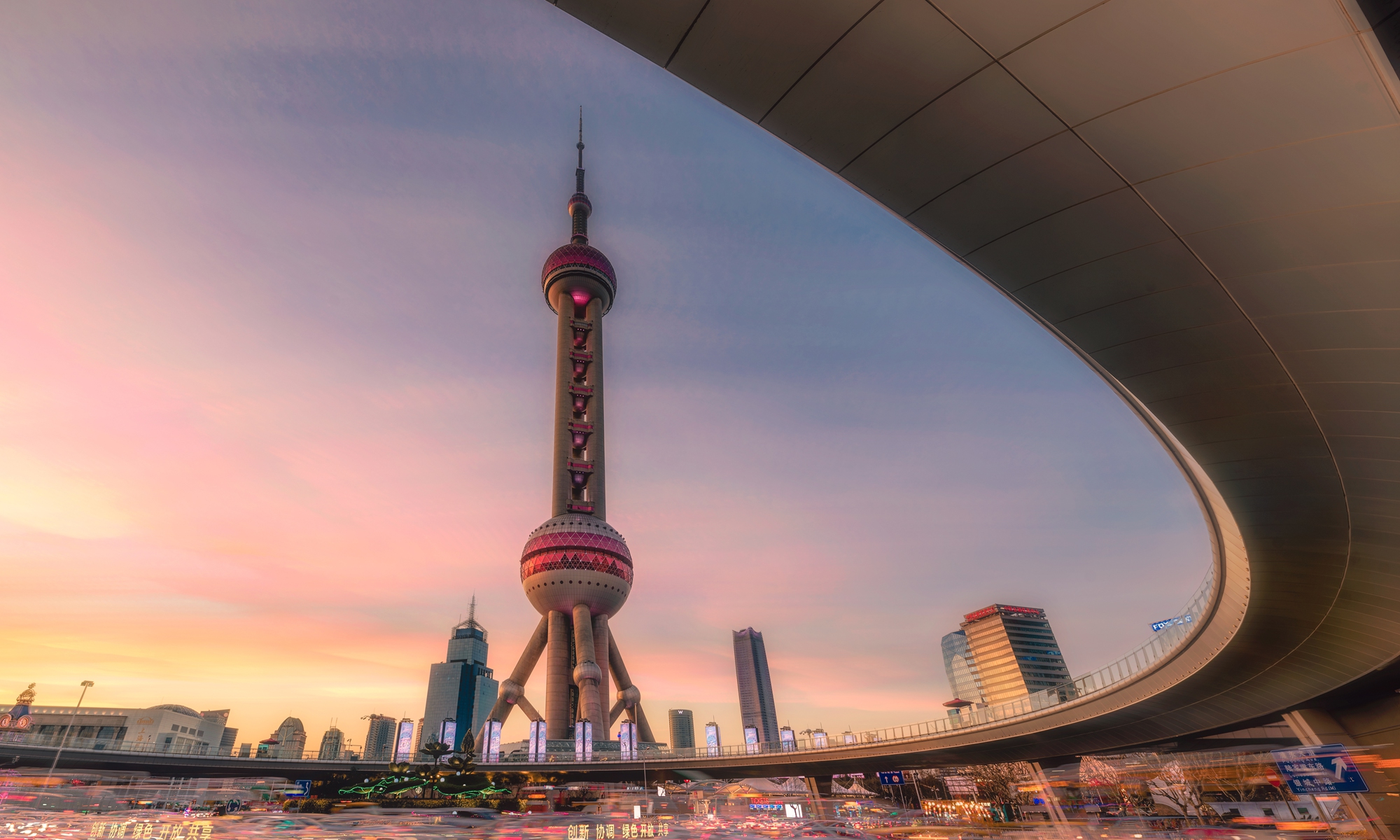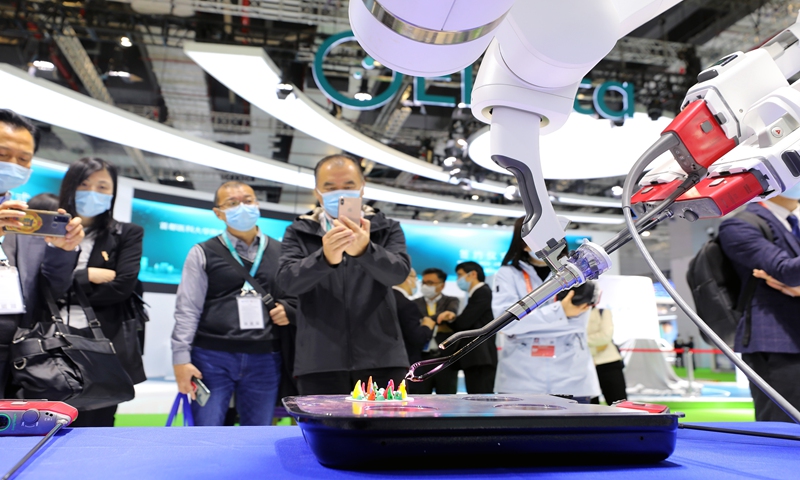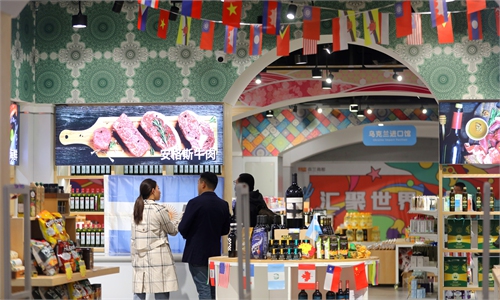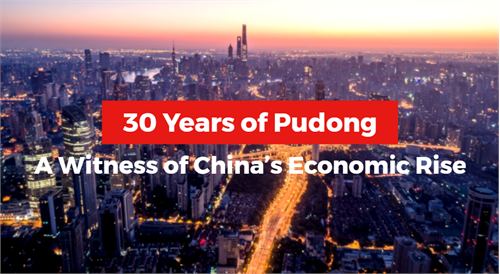
The Oriental Pearl Tower in Shanghai. Photo: VCG
As the world's largest import fair wound down this week with deals in the billions of dollars, which offer fresh hope to global economic recovery amid the coronavirus pandemic, Shanghai, where the event was held, continues to take center stage as China seeks to highlight the impressive achievements of its opening-up and its unswerving resolve to push further the long-standing policy against a rising set of hurdles, ranging from a public health crisis to geopolitical tensions.
When Zhang Hao first came to Pudong, a district of Shanghai, in the 1990s, he had to share one desk with two or three colleagues and sometimes borrowed office supplies from other local government agencies because the district located east of the Huangpu River was then almost deserted and office supplies were scarce. Zhang was among the first batch of pioneers who followed the central government's call to build the Pudong New Area into China's "trump card" and an economic reform model for the rest of the country.
Zhang, who is now vice general manager of a trading and services provider Shanghai Waigaoqiao Group, remembers those early years of urban development in the most symbolic city in the country that has also experienced a vast transformation.
Pudong area in Shanghai undertook the path of economic reform and opening-up in 1990 at the moment when the Soviet Union collapsed and China needed to pivot its focus to finding its own development path as it faced rising doubts of the West over its socialist path.
For many pioneer officials and business representatives like Zhang who took part in the development of Shanghai's Pudong New Area, the history reinforced their belief that the current difficulties, especially the economic war launched by the Trump administration toward China "are not a big deal" and will not shake the country's determination to open to the world.
"At the early stage of the economic reform in Pudong New Area, especially the institutional reform, like how we would govern and transform to a market-driven economy, we faced more uncertainties as no one had done it before," he told the Global Times.
It required tremendous courage to push us to advance the opening-up at that moment, the official said, noting that this spirit is still relevant to today's China as its opening-up commitment to the world remains unchanged.
2020 marks the 30th anniversary of Pudong New Area's development and opening-up. Along with Shenzhen, another pilot city that carries on the central government's grand vision of opening-up, the story of Pudong is seen as a clear answer to the doubts raised by some Western countries on whether China would turn inward to decouple with the outside world amid the coronavirus pandemic and confrontation with the US, observers said.
Full-speed opening-up
Over the past 30 years, Pudong's GDP rose from 6.024 billion yuan in 1990 to 1.27 trillion yuan in 2019. The district's reform and opening-up has also led the economic transformation of Shanghai and the country.
In an attempt to explore institutional reform by streamlining administrative processes, authorities in Pudong have not stopped trying to expand the scope of innovation in maximizing market access for foreign investment.
From coming up with China's first negative list for foreign companies to creating many firsts in areas such as attracting foreign investment, approving foreign-funded financial institutions and absorbing foreign professionals, Pudong has become much more impressive not only by its ambition but also by its speed.
When business representatives refer to "Pudong speed," the most recent example is "Tesla speed," referring to Tesla's Shanghai Gigafactory which was built in the district's industrial suburb of Lingang. Within just half a year, the US tech giant, which is the first wholly foreign-owned automaker in China, completed the deal and land acquisition, Gu Changshi, director of Lingang's investment promotion and services center, told the Global Times.
"We won't be simply satisfied with 'Tesla speed.' We hope to make the investment-approval process even more efficient. Recently, we approved a project within four months," he said, adding that the approval period is expected to be shortened to three months or less.
For many foreign business representatives, the vast transformation of the district, which mirrored the overall growth of China, has been impressive. Tsunetaka Mori, vice president of Japanese firm Itochu East Asia Bloc, told the Global Times that when he first came to Shanghai in 1988, "Pudong was a rural area."
Being attracted by favorable policies on tax and staff management, the Japanese company is now planning to further consolidate its presence in China in order to cover a broader market, despite the complex external environment like the China-US trade war.
In the face of growing external pressure, China is advancing its new "dual circulation" strategy, which foreign businessmen like Mori are closely observing.
"We hope it's not turning inward, we hope it's healthy interactions with foreign investment while we see the determination of the central government in further opening up to the world remain unchanged," the Japanese businessman said.

A surgical robot of da Vinci Surgical Systems makes its debut at the 3rd China International Import Expo (CIIE) on Thursday. Using the robot, doctors can perform complicated surgery in a narrow area of the human body. Photo: Yang Hui/GT
Future path
During the opening ceremony of the third China International Import Expo (CIIE) on November 4, Chinese President Xi Jinping highlighted China's unwavering commitment to further opening up its market to global businesses, and helping boost global cooperation, as the world faces tremendous risks and uncertainties from COVID-19, rising protectionism and other challenges.
This year's CIIE in Shanghai came shortly after the fifth plenary session of the 19th Central Committee of the Communist Party of China (CPC), which set pragmatic targets for the next five and 15 years of the country's development.
It was also held at the moment when the Chinese academics, businesses and policymakers are seeking to review the experiences of the two landmark cities - Shanghai and Shenzhen - as part of the pioneer practice of economic reform and opening-up, which conveys a strong message to the world that China will not stop deepening its reforms and opening up its economy to the world despite growing challenges.
Tomas Kuta, senior vice president of sales at Volvo Construction Equipment in Asia, said he had not sensed any change in the business environment in China, even as some Western media interpreted China's new dual-circulation strategy as an inward-facing strategy that reduces exposure to the outside world.
As a Swedish business representative, Kuta told the Global Times that he meets frequently with Chinese government officials and in no sense are foreign companies being disadvantaged or feeling blocked.
For some foreign companies that have participated in Shanghai's reform and opening-up process, they see China as a promising market where they see the future, especially after the country becomes the first to effectively contain the COVID-19 epidemic and registers a strong recovery.
"We hold a positive view on China's future growth no matter how the external environment changes," Liang Rui, head of Swiss industrial giant ABB Robotics in China, told the Global Times.




